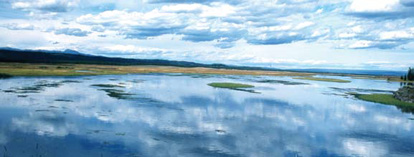Surface Film
Surface film tension is the property of a liquid by which it acts as if its surface is a stretched elastic membrane. This tension allows insects to stand on the water’s surface. Surface film tension is caused by the attraction of water molecules to each other; in addition, the surface molecules are attracted to the underlying molecules.
The amount of surface film tension is affected by both temperature and dissolved substances. An increase in temperature lowers the net force of attraction among molecules and so decreases the surface tension. An increase in dissolved organic substances also lowers the surface tension. However, an increase in dissolved inorganic salts causes a rise in surface tension. So if you want to try to walk on water, do so on a cold day in a salty lake.
Surface film tension is the property which allows items that are not wetted to float. It is also the reason why floatant is placed on our lines and flies to prevent these objects from being wetted. They will float on the surface film.
The surface film also reflects light; similarly, it reduces the amount of light entering the water. This influences both the angler’s and the fish’s vision.
Emerging aquatic insects must be able to break through this surface tension to reach the air. At times, when this surface tension is great, insects have difficulty emerging through the surface. They may become trapped in the surface film and vulnerable to fish predation. The cooler, overcast days provide a longer surface duration of insects hatching because they have more difficulty piercing the surface film. Being trapped at the surface, insects are forced to drift for a prolonged time.
Surface tension commonly traps terrestrial insects which fall into the water. An increase in surface tension makes it more difficult for these terrestrial insects to escape.
Hence cooler temperatures enhance the angling production during emergences of midge, mayfly, and caddisflies by prolonging the insect’s presence at the surface.
A fresh rain may cause an increase in dissolved organic or inorganic substances in the water. If it’s an increase in inorganic salts, the surface tension rises; on the other hand, if it’s an increase in organic substances, the surface tension lowers.
Warm temperatures favor the insect’s escape by lowering the surface tension. During warmer temperatures, hatching insects are not on the surface for long. During extremely high surface tension

times heavy objects such as snails may be found floating.
Best dry fly conditions are when the surface film tension is high. The trapped insects are prolonged at the surface and this elicits fish predation.

© 2026 The Gale Group, Inc. All rights reserved.
© 2026 Perigee Learning LLC. All rights reserved.
LoveTheOutdoors.com is owned and operated by Advameg, Inc. © 2026 Advameg, Inc.
Camping Adventures • Dutch Oven Cooking • Sports Knots
Fly Tying • Freshwater Fishing • Fly Fishing

